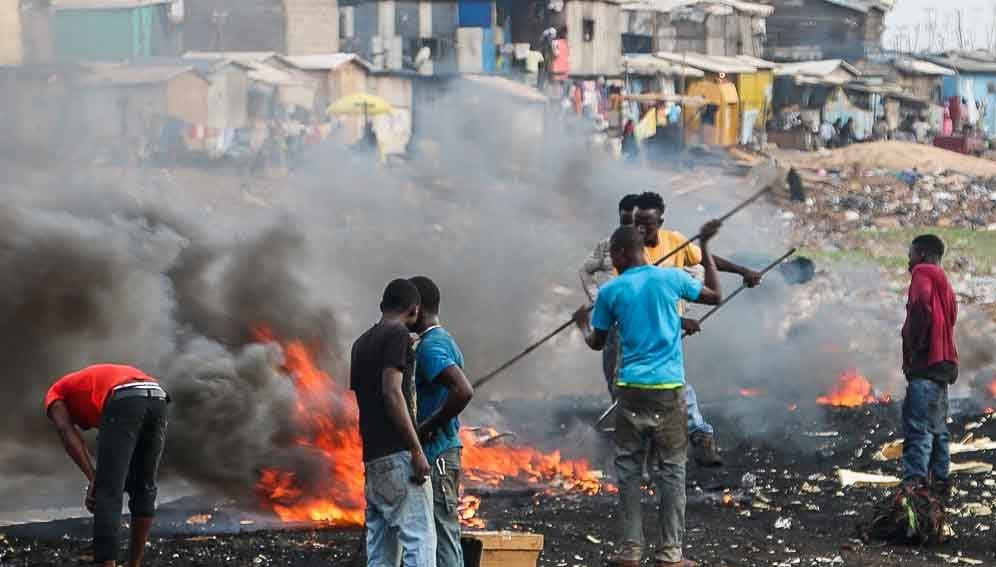12/01/21
Countries face emissions ‘cocktail’ from waste burning

By: Gareth Willmer
Send to a friend
The details you provide on this page will not be used to send unsolicited email, and will not be sold to a 3rd party. See privacy policy.
Uncontrolled solid waste burning is releasing a “hazardous cocktail” of emissions that threatens people, workers and the environment in lower- and middle-income countries, says a report.
Worldwide, around one billion tonnes of municipal solid waste — half of what is generated every year — is not properly managed, estimates the Global Review on Safer End of Engineered Life. Based on the existing evidence, the study reported that 24 per cent of global waste is uncollected and another 27 per cent mismanaged post-collection.*
Open burning is used to deal with much of this, including plastic, medical, electronic and construction waste, potentially releasing long-term environmental pollutants and toxic substances linked to immunological and developmental impairments.
The problem is particularly prominent in the global South, says the report commissioned by Engineering X, an international collaboration founded by the UK’s Royal Academy of Engineering and independent global charity Lloyd’s Register Foundation.
“If you drink foul water, you’ll get ill. But [with burning], the link between the damage done and the problem is not so obvious,”
Costas Velis, researcher, University of Leedss
But while open waste burning is thought to be widespread, the study of published evidence about the issue highlights the “surprisingly” limited data on volumes burned and their impact, saying much more research is needed to ascertain the full extent of the problem.
Resource shortage
While the need to deal with waste is urgent, governments and authorities “don’t necessarily have the resources to do so, or they don’t prioritise it or there are issues with the budget,” says Costas Velis, a researcher in environmental engineering and the circular economy at the University of Leeds, UK, who co-authored the report. Burning waste, he says, can be a case of “out of sight, out of mind”.
In addition, from a prioritisation and research perspective, Velis says there is often a heavier focus on problems with clearer immediate effects, such as water and sanitation. “If you drink foul water, you’ll get ill. But [with burning], the link between the damage done and the problem is not so obvious.” That also makes it harder to get to the root of the problem, he adds.
Ed Cook, a research fellow in circular economy systems for waste plastics at the University of Leeds who also worked on the report, emphasises the need to improve knowledge of potential health impacts and substances burned — especially amid expected increases in global waste.
“You can determine that something is likely to have an impact on [for example] the endocrine system, but the impact on populations as a whole is less certain,” says Cook. Again, he says, data scarcity is a challenge, while lab research on the effects of emissions may not be applicable to all the conditions surrounding open waste fires.
The report points out that the problem is exacerbated because simply stopping burning would leave vast quantities of waste endangering the environment, while medical waste is often burnt to prevent problems such as blood-borne viruses. Businesses and governments urgently need to “find ways to manage safely the world’s solid waste using the most cost-effective methods available”, aided by better data to pinpoint harmful effects, the report says.
Waste solutions
The world’s “waste pickers” — an informal 11 million-strong global workforce estimated to gather more than 90 million tonnes of waste annually for recycling —and their families face heightened exposure to pollutants, as well as risks from diseases and injuries, says Cook. “They’re providing this tremendous service to humanity, yet they are marginalised, stigmatised, and exposed and vulnerable to all these health risks,” says Cook. “It’s time that these people were recognised for the work they do in waste management plans.”
The report offers recommendations to improve practices and data, highlighting “a need to adjust research agendas and form genuine collaboration between low-income and middle-income countries and high-income countries on these neglected cross-cutting thematic areas”.
Zoë Lenkiewicz, a senior technical advisor at UK-based international waste management charity WasteAid, believes the practice of open burning is “commonplace” in Sub-Saharan Africa and Asia, but it requires more attention.
“People in poverty are the most likely to be burning their waste, and also the most likely to be affected by it directly — by breathing in fumes — and indirectly, via the impacts of living in a poor environment and climate change,” said Lenkiewicz, who was not involved in the report.
But with about one in three people globally lacking access to waste management facilities, she says the problem of waste management is “underaddressed”. Nevertheless, she says, there are some simple systems to help alleviate the burden, such as reusable alternatives and community composting systems.
“Waste management has lacked global attention historically, and we are pleased to see more attention being directed towards this significant threat to the environment and human health,” she added.
* This article was corrected on January 13, 2020, to clarify that one billion tonnes of municipal waste is not properly managed, not “left in the environment” as previously stated.















